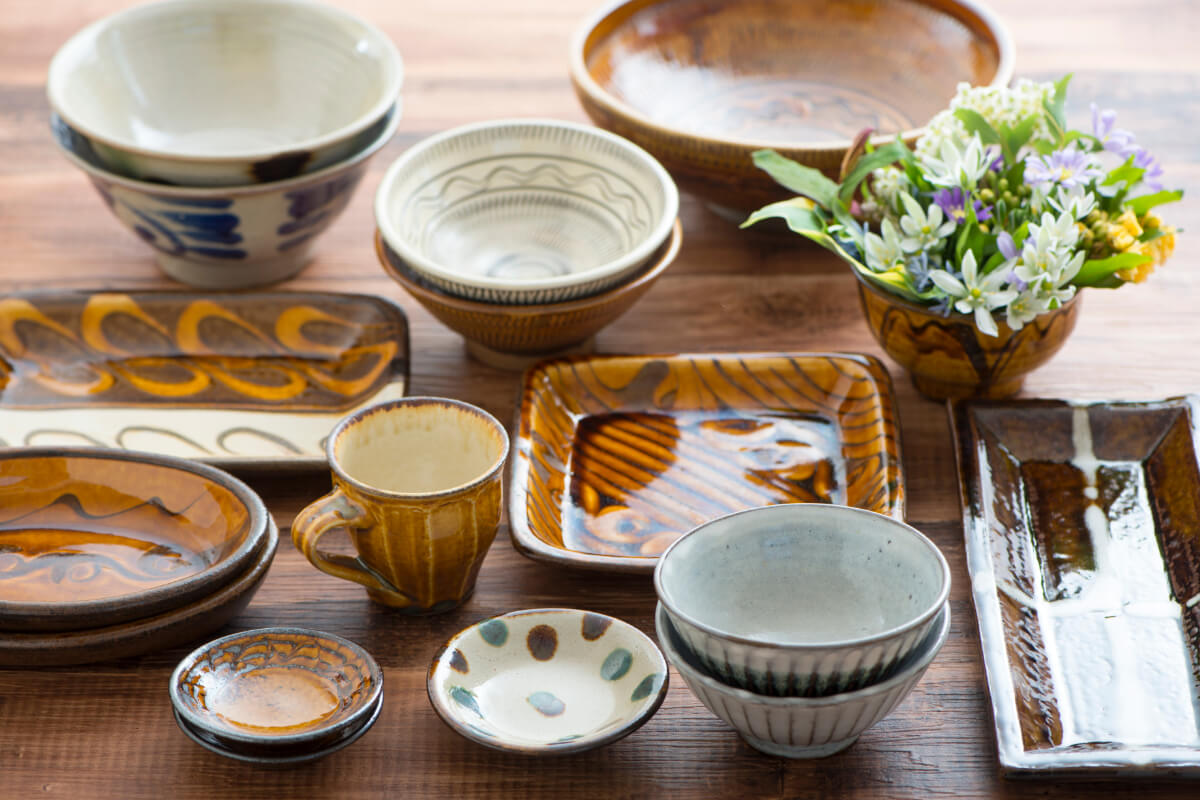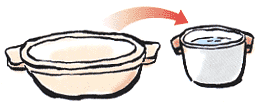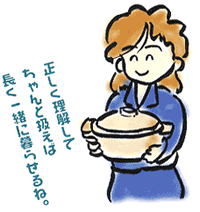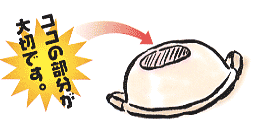土鍋

ヘルシーで簡単に調理でき、家族団らんにも活躍する鍋料理。そんな鍋料理に欠かせないのが土鍋です。遠赤外線の効果で食材を美味しく加熱するほか、金属土鍋に比べて蓄熱性が高いためガスや電気の使用量が少なく済みエコにも一役買います。また、より長く使うことで良い風合いが出てきます。
特性を理解し、こんなことはしないで

てんぷら・フライ等の「揚げ物」には危険ですから絶対に使用しないでください。火災になる恐れがあります。また「空焚き」をしないでください。土鍋の電熱器でのご使用は、熱がこもるため危険ですので使用しないでください。また熱い鍋を急に冷たい所へ置かないでください。
水気をふき取ってから
ご使用前は、土鍋の外側の水気を拭き取り弱火からご使用下さい。
土鍋に煮汁を入れたままにしていませんか

土鍋に残った煮汁は早めに別の器に移して、ぬるま湯で洗いましょう。そのあと中性洗剤をつけたスポンジでしっかり洗います。
お餅のこびりつきは必ずとりましょう。
お湯と中性洗剤でふやかし、割り箸などでこそげとります。早めに処理して清潔に使いましょう。
底面の汚れはしっかり洗いましょう。
釉薬が塗られていない底面も、中と同じように中性洗剤で。そして洗った後は良く乾かしましょう。水を含みやすい底面を上にして、しっかり乾かします。
買ったときの段ボール箱をそのまま収納に利用しましょう
ダンボールは吸湿性が高いので、土鍋を湿気から守ってくれます。

- かび臭さは酢が効果的です
- 酢の殺菌、消臭効果を利用して、においを消します。たっぷりの水を入れた土鍋に、酢大さじ2~3杯を目安に加え、10分ほど煮立てるだけでOKです。
- 食べ物のにおいは茶殻で取れます
- 土鍋にたっぷりの水と茶殻(緑茶やほうじ茶など)をひとつかみ入れて、火にかけ10分ほど煮立てます。茶に含まれる成分がいやな臭いを吸収してくれます。
- ひびはお粥のデンプン質でうめます
- ひびはそのままにしておくと臭いやかびのもとになります。気がついたら早めにおかゆを炊いて、デンプン質でひびを埋めます。残りご飯を煮ても効果があります。

IH対応土鍋
火を使わずに調理ができるIH。便利なようですが、専用に開発された電磁調理器もその特性を理解し正しく使い、有効に利用しましょう。
底面にコゲつかない様に注意しましょう
食材が底面にコゲつくと、その部分が異常発熱し超高温となり、土鍋内部の特殊フィルムが破損いたしますので、注意が必要です。
保存容器に使っていませんか?
IH土鍋は大変吸水性が高いため、保存用器しての使用は避けてください。調理の後は、残った食材は別容器に素早く移して、再度ご使用ください。
皮膜加工部はスポンジでお手入れを
内部の特殊な皮膜加工部には、クレンザー・金属タワシの使用は避けて、スポンジと中性洗剤をご使用ください。
特性を理解して注意をしましょう
天ぷら・フライ等の揚げ物料理には使用しないでください。また、空焚き、着け置き洗いは故障・破損の原因になりますので避けてください。また、調理中に「ブーン」、「ジー」など共振音がすることがありますが、異常ではありません。鍋の位置をずらすか、置き直すと止まることがあります。

- 時間短縮でお料理
- だし汁だけを先に沸騰させて土鍋の側面も加熱しておくと、具材を入れてから再度沸騰するまでの時間を短縮できるうえ、火加減も多少弱くできますので焦げ付きにくくなります
- 粘性の高い食材について
- 粘性の高い食材、特に餅、おかゆ、雑炊、昆布、うどん、とき卵などを調理する場合は、以下の点にご注意ください
- 粘性の高い食材をなるべく上のほうに置いて調理し、鍋底に置かないようにする
- ダシ汁の量を十分に保ち、煮つまりとコゲつきに注意する
- 具材の量は8分目くらいが適当量。いっぱいに入れると焦げ付きの原因に
- 食材を早めに頻繁にかき混ぜて、焦げ付きを避ける
- 保温の際は火力を弱め、火加減を調節する
